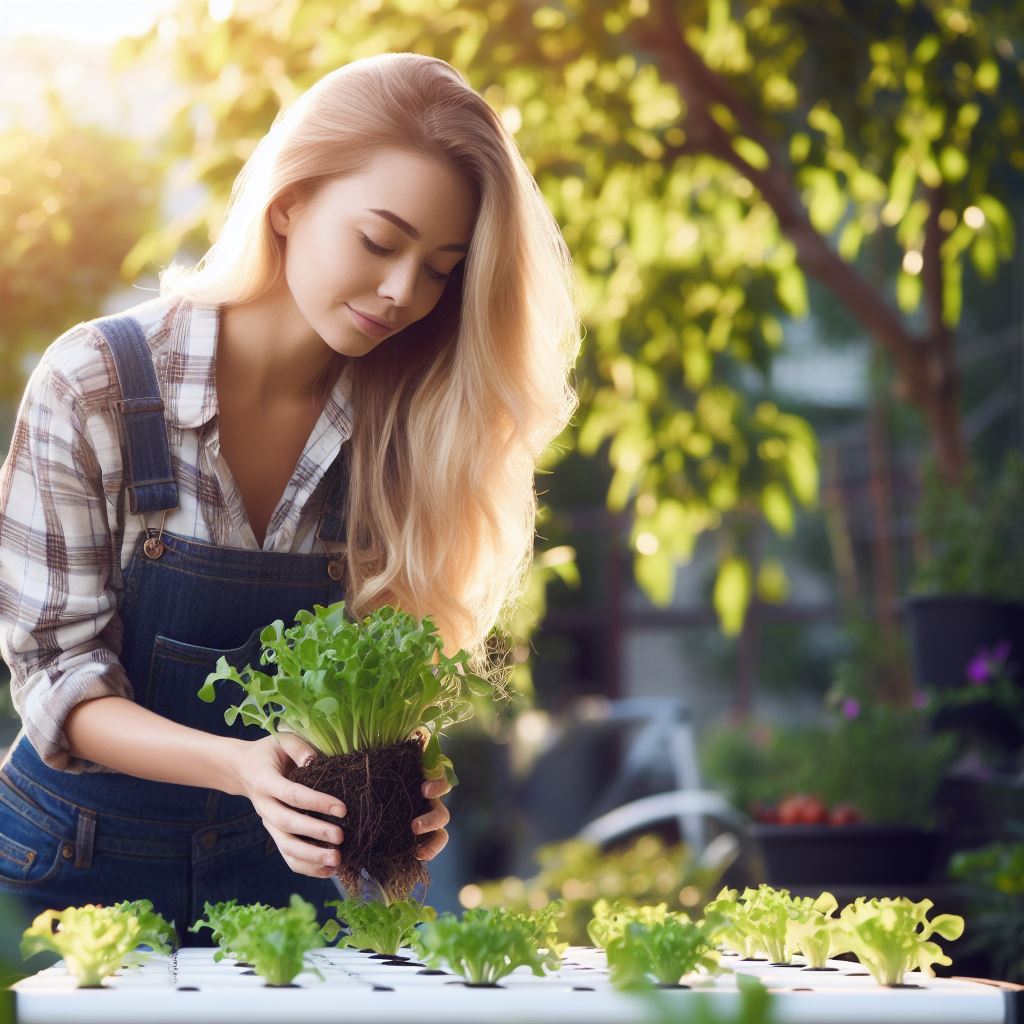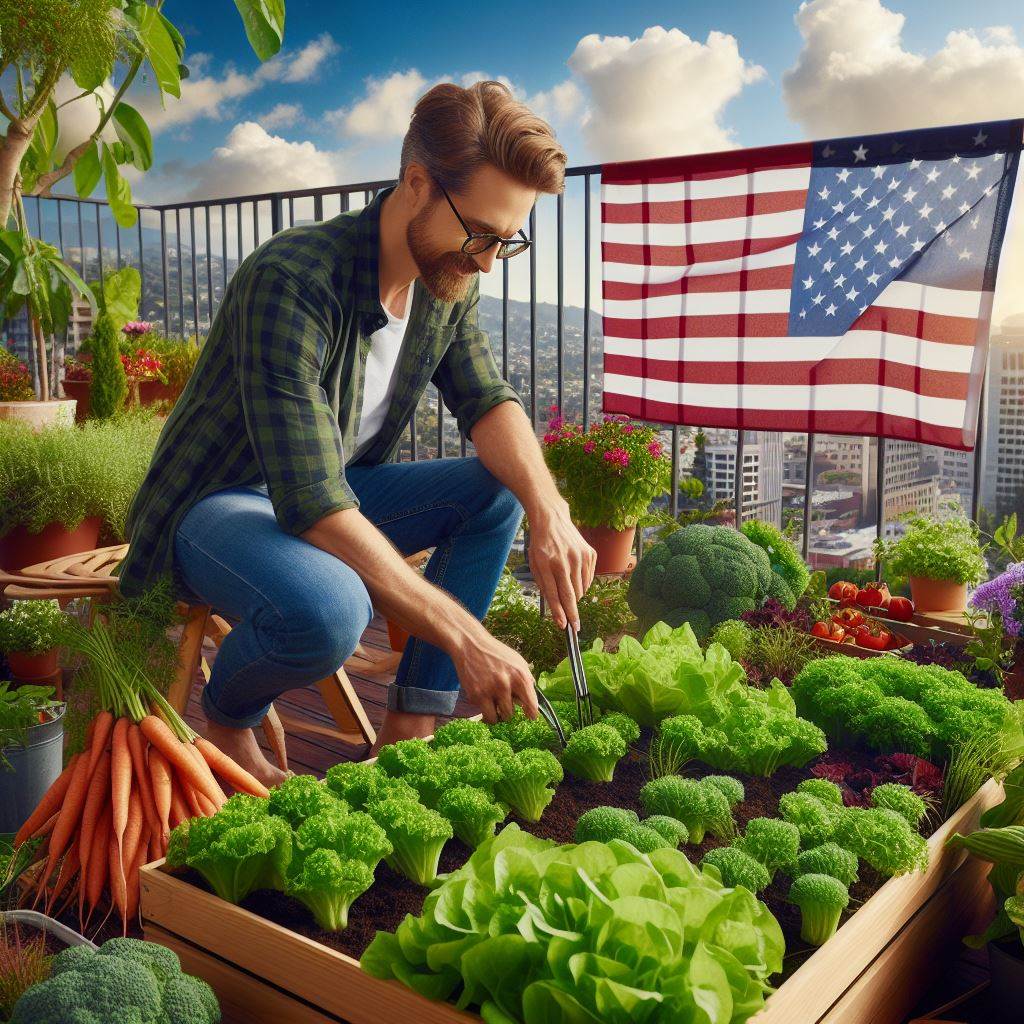Introduction
Composting is the process of organic material decomposition that transforms waste into nutrient-rich soil.
For urban farmers, composting plays a crucial role in sustaining healthy and productive gardens.
In the bustling heart of urban landscapes, where concrete jungles meet the promise of sustainable living, a quiet revolution is taking root — one compost bin at a time.
Urban farmers, armed with a commitment to both harvests and harmony, are turning to the transformative practice of composting.
In this blog post, we will explore the definition of composting and its significance for urban farmers.
This guide is a beacon for those navigating the dynamic intersection of urban living and sustainable agriculture, offering insights, strategies, and a roadmap to harness the power of compost.
As city skylines evolve, so too must our approach to cultivation.
Composting emerges as a pivotal player in this narrative, bridging the gap between waste and nourishment, between bustling streets and thriving gardens.
Join us in this journey through the intricate layers of composting tailored for urban farmers.
From balcony gardens to community plots, this guide explores not only the technical aspects of composting but also the ethos of sustainable living that it embodies.
Unravel the mysteries of composting as we delve into the hows and whys, empowering urban farmers to transform kitchen scraps and green waste into gold for their crops.
Together, let’s cultivate not just vegetables but a greener, more sustainable urban future.
Welcome to “Composting: A Guide for Urban Farmers” — your passport to cultivating a vibrant, eco-conscious oasis amidst the urban hustle.
Benefits of Composting in Urban Farming
Reduces waste sent to landfills
Composting is an effective method for urban farmers to reduce the amount of waste that goes to landfills.
By composting organic waste such as food scraps and yard trimmings, farmers can divert these materials from the landfill.
Transform Your Agribusiness
Unlock your farm's potential with expert advice tailored to your needs. Get actionable steps that drive real results.
Get StartedThis helps to alleviate the strain on landfills and reduces the production of greenhouse gases that contribute to climate change.
Improves soil quality and fertility
Composting is a natural way to enhance the quality and fertility of soil in urban farming.
Adding compost to the soil improves its structure, making it more crumbly and easier to work with.
Compost is rich in organic matter, which provides essential nutrients that plants need to grow and thrive.
The organic matter also acts as a sponge, retaining moisture in the soil and preventing it from drying out too quickly.
Increases water retention in soil
One of the benefits of composting in urban farming is the improvement in water retention.
Compost helps to create a soil structure that is porous, allowing it to absorb and store water more efficiently.
This means that during dry periods, the soil will retain moisture for longer periods, reducing the need for additional irrigation.
The increased water retention also helps to prevent soil erosion and runoff, protecting nearby waterways from pollution.
Minimizes the need for chemical fertilizers and pesticides
Composting in urban farming can reduce reliance on chemical fertilizers and pesticides.
Compost contains a range of nutrients that plants need, including nitrogen, phosphorus, and potassium.
By adding compost to the soil, farmers can provide these nutrients in a natural and sustainable way, reducing the need for synthetic fertilizers.
Additionally, compost helps to improve soil health and create a balanced ecosystem, making plants more resistant to pests and diseases.
By minimizing the use of chemical fertilizers and pesticides, urban farmers can promote healthier food production and protect the environment.
In essence, composting offers numerous benefits for urban farmers in their quest for sustainable and efficient farming practices.
By reducing waste sent to landfills, improving soil quality, increasing water retention, and minimizing the use of chemical inputs, composting empowers urban farmers to grow healthy and nutritious crops in a responsible manner.
As more urban areas embrace farming practices, composting will continue to play a crucial role in ensuring the success and sustainability of urban agriculture.
Getting Started with Composting
Understanding the basics of composting
Composting is a valuable practice for urban farmers as it allows them to efficiently recycle organic waste and create nutrient-rich soil for their crops.
To get started, it’s essential to understand the basics of composting, including the types of organic materials suitable for composting and the factors that influence the composting process.
Organic materials such as fruit and vegetable scraps, coffee grounds, and yard waste are suitable for composting.
However, it’s important to avoid materials like meat, dairy, and invasive weeds as they can introduce unwanted pests or diseases into the compost pile.
Several factors influence the composting process, namely temperature, moisture, and aeration.
Compost piles should ideally maintain a temperature between 120°F and 160°F to facilitate decomposition.
Adequate moisture, around 40-60%, ensures that the microorganisms responsible for composting thrive.
Showcase Your Farming Business
Publish your professional farming services profile on our blog for a one-time fee of $200 and reach a dedicated audience of farmers and agribusiness owners.
Publish Your ProfileRegularly turning the compost pile helps maintain proper aeration, ensuring that oxygen reaches all parts of the pile.
Choosing the right composting method for urban farmers
Choosing the right composting method is crucial for urban farmers.
Traditional composting bins, such as tumblers or stationary bins, are popular options as they are easy to manage and require minimal space.
They provide a controlled environment for composting and allow for the decomposition of a variety of organic materials.
Vermicomposting, also known as worm composting, is another method that urban farmers can consider.
It involves using specific species of worms, such as red wigglers, to break down organic waste. Vermicomposting is particularly suited for small-scale composting and can be done indoors or outdoors.
Bokashi composting is a lesser-known method that utilizes beneficial microorganisms to ferment organic waste.
It is an excellent option for urban farmers with limited space, as it can be carried out indoors without producing foul odors.
Bokashi composting also accepts a wider range of materials, including meat and dairy products.
Obtaining composting materials
Obtaining composting materials is relatively easy for urban farmers.
Kitchen scraps, grass clippings, leaves, and plant trimmings can be collected from both indoor and outdoor sources.
It’s important to strike a balance between carbon-rich materials like dry leaves or shredded newspaper and nitrogen-rich materials like green kitchen waste or fresh grass clippings.
Avoiding certain materials is also crucial for successful composting.
Meat, dairy products, oils, and fats can attract pests and create unpleasant odors.
Additionally, invasive weeds are best kept out of the compost pile, as they may spread and take root in the garden bed once the compost is used.
By understanding the basics of composting and choosing the right method, urban farmers can embark on a sustainable practice that enriches their soil and reduces waste.
Obtaining appropriate composting materials further ensures the success of their composting endeavors, allowing them to grow healthy crops and contribute to a greener environment.
Read: Balcony Gardens: Growing in Small Spaces
Composting Techniques for Urban Farmers
Layering method for composting bins
One effective technique for urban farmers to compost is the layering method.
This method involves creating alternating layers of organic materials in composting bins.
By layering different types of organic matter, you can accelerate the decomposition process and produce nutrient-rich compost.
To start with, gather a variety of organic materials such as fruit and vegetable scraps, coffee grounds, yard waste, and shredded paper.
Begin by placing a layer of yard waste or shredded paper at the bottom of the bin.
This layer serves as the base and helps with drainage.
Next, add a layer of fruit and vegetable scraps on top of the yard waste or shredded paper.
Make sure to break up any large pieces to hasten the decomposition process.
Sprinkle a layer of compost accelerator, such as finished compost or manure, on top of the food scraps.
This helps to introduce beneficial microorganisms that aid in decomposition.
Continue layering organic materials, alternating between high-nitrogen materials like kitchen scraps and grass clippings, and high-carbon materials like dry leaves or straw.
Ensure that each layer is evenly spread and compacted to create an ideal environment for decomposition.
Alternate between moist and dry layers to maintain the right moisture level.
Maintaining the right moisture level
It is crucial for urban farmers to maintain the correct moisture level in their compost piles.
Inadequate moisture can slow down the decomposition process, while excess moisture can lead to a smelly, anaerobic pile.
The ideal moisture level should resemble a wrung-out sponge.
To maintain proper moisture, regularly check the compost pile by grabbing a handful and squeezing it.
If it feels dry, add water using a watering can or hose.
Ensure the water is evenly distributed throughout the pile.
If it feels too wet, incorporate additional dry, high-carbon materials like straw or shredded paper to absorb excess moisture.
Ensuring proper aeration in the compost pile
Proper aeration is essential for successful composting. Oxygen is required for the microorganisms responsible for decomposition to thrive.
A well-aerated compost pile breaks down organic materials efficiently and prevents the formation of foul odors.
Showcase Your Farming Business
Publish your professional farming services profile on our blog for a one-time fee of $200 and reach a dedicated audience of farmers and agribusiness owners.
Publish Your ProfileTo ensure adequate aeration, regularly turn or mix the compost pile using a garden fork or compost turning tool.
This helps to prevent compacting and creates air pockets necessary for beneficial bacteria to flourish.
Aim to turn the pile every one to two weeks, or when the internal temperature increases. This process also helps distribute moisture and speed up decomposition.
Monitoring and adjusting temperature
Monitoring the temperature of your compost pile is crucial to understand the decomposition process and make necessary adjustments.
The ideal temperature range for composting is between 120°F and 160°F (49°C and 71°C).
This temperature range ensures the destruction of pathogens and weed seeds.
Use a compost thermometer to periodically check the internal temperature of the pile.
If the temperature remains too low, it indicates insufficient nitrogen.
Add more high-nitrogen materials, such as fresh grass clippings or vegetable scraps, to increase the temperature.
On the other hand, if the temperature exceeds 160°F (71°C), it suggests an excess of nitrogen.
In this case, add more high-carbon materials like dry leaves or straw to cool down the pile.
Using composting tools and equipment
To effectively manage composting as an urban farmer, it is beneficial to have the appropriate tools and equipment.
Invest in a sturdy compost bin or construct one using materials like wood pallets or wire mesh.
The bin should have sufficient capacity to accommodate your composting needs.
Other essential tools include a garden fork for turning the compost pile, a compost thermometer for temperature monitoring, and a watering can or hose for maintaining proper moisture levels.
These tools will aid in the successful decomposition of organic materials and allow you to produce high-quality compost for your urban farm.
In a nutshell, employing composting techniques such as the layering method, maintaining the right moisture level, ensuring proper aeration, monitoring temperature, and using appropriate tools, urban farmers can efficiently produce nutrient-rich compost.
Composting is a sustainable practice that promotes recycling organic waste, enriches soil fertility, and contributes to the overall health of urban farming.
Read: Soil Health: Tips for Small-Scale Farmers

Troubleshooting Common Composting Issues
Foul odors in the compost pile
- Ensure proper balance of green and brown materials to avoid excess moisture and anaerobic conditions.
- Turn the compost regularly to increase airflow and prevent the buildup of odor-causing bacteria.
- Avoid adding meat, dairy, or oily foods that can lead to unpleasant smells.
- Cover the compost pile with a breathable material like burlap to contain odors and deter pests.
Attracting pests or rodents
- Avoid adding food scraps that attract pests, such as meat, dairy, or oily foods.
- Use a closed compost bin or secure the compost pile with wire mesh to prevent rodents from accessing it.
- Avoid adding pet waste or any animal products that can attract pests.
- If pests persist, try sprinkling red pepper flakes or installing a motion-activated deterrent near the compost area.
Slow decomposition and lack of progress
- Ensure the compost pile has a proper balance of green and brown materials.
- Chop or shred larger items to speed up decomposition.
- Mix the compost pile regularly to provide oxygen and distribute microorganisms.
- Maintain the correct moisture level by adding water if it’s too dry or increasing ventilation if it’s too wet.
- Consider using compost activators or inoculants to introduce beneficial microorganisms.
Insufficient or excess moisture
- Monitor the moisture level regularly by squeezing a handful of compost. It should feel like a damp sponge.
- Add water to dry compost to achieve the correct moisture balance.
- If the compost is too wet, mix in dry brown materials like dried leaves or shredded newspaper.
- Cover the compost pile during heavy rain to prevent excessive moisture.
Addressing composting challenges in small spaces
- Choose a composting method suitable for small spaces, such as vermicomposting or bokashi composting.
- Use a small-scale composting bin or compost tumbler that fits in limited areas.
- Minimize odors by layering food scraps with carbon-rich materials like shredded paper or dried leaves.
- Utilize balcony or indoor composters if outdoor space is limited.
- Harvest finished compost regularly to create space for ongoing composting in small containers.
Read: Hydroponics: Future of Urban Farming?
Harvesting and Using Compost
Signs of compost readiness
Compost is a valuable resource for urban farmers, offering numerous benefits for soil health and plant growth.
Once the compost is ready for use, specific signs indicate its readiness.
The compost should have a dark brown or black color with a pleasant earthy smell, indicating that it has undergone decomposition.
Look for a crumbly texture, similar to rich soil, without any visible traces of the original organic materials.
The presence of earthworms and other beneficial organisms is also a positive sign that the compost is mature.
Harvesting techniques for different composting methods
Harvesting techniques vary depending on the composting method used.
For hot composting, which involves maintaining high temperatures, it is recommended to use a garden fork to turn the pile every couple of weeks.
This helps to aerate the compost and speed up the decomposition process.
On the other hand, cold composting requires collecting the finished compost from the bottom of the bin while leaving the top layers to continue decomposing.
This allows for a continuous supply of compost.
Vermicomposting, which involves the use of worms, requires moving all the contents to one side or corner of the worm bin.
This allows the finished compost to be harvested from the other side, while the worms continue their work in the remaining area.
Incorporating compost into urban farming practices
Once the compost has been harvested, it can be incorporated into urban farming practices in various ways.
One method is top dressing, which involves sprinkling a thin layer of compost on the soil surface around potted plants and raised beds.
This provides a slow-release source of nutrients and helps retain moisture in the root zone.
Compost can also be used as a soil amendment when preparing garden beds.
Mix it into the existing soil to improve its nutrient content and water-holding capacity.
This enhances plant growth and overall soil health. Additionally, compost can serve as mulch when applied around plants.
This layer of compost helps suppress weeds, regulate soil temperature, and conserve moisture.
In summary, harvesting and using compost is an essential part of urban farming.
Showcase Your Farming Business
Publish your professional farming services profile on our blog for a one-time fee of $200 and reach a dedicated audience of farmers and agribusiness owners.
Publish Your ProfileUnderstanding the signs of compost readiness and implementing appropriate harvesting techniques ensure that the compost is used at its best.
Incorporating compost into various farming practices, whether through top dressing, soil amendment, or mulching, contributes to healthier plants and more productive urban farms.
Read: Pest Control: Natural Solutions for Small Farms
Conclusion
Composting is essential for urban farmers as it enhances soil health, reduces waste, and saves money.
Composting, a game-changer for urban farmers, transforms waste into gold—nourishing soil, reducing landfill load, and fostering sustainability.
Embark on the composting journey now! Witness firsthand how kitchen scraps and green waste revolutionize your urban farming experience.
Composting is not only beneficial for urban farmers but also for the entire community.
In the fertile embrace of compost, urban farmers find a sustainable ally.
Join the movement, sow the seeds of change, and cultivate a greener, healthier urban landscape.
Your composting endeavors are not just about waste; they’re about sowing the seeds of sustainability, reaping a harvest of resilience, and fostering a sustainable urban farming ecosystem.
The power to transform your environment lies in your hands—start composting today and be a steward of positive change.
Let’s take action now and make a difference! Start composting and be part of the solution.




